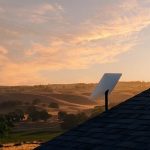Last month, I got my hands on the soon-to-be-released 3D camera from Sony; the HXR-NX3D1U. Broadcast Pro Middle East called and asked if I would like to test this camera for the weekend and report my experience. Being one of the few stereographers in the region, and rarely getting gear to play around with, I […]
Last month, I got my hands on the soon-to-be-released 3D camera from Sony; the HXR-NX3D1U. Broadcast Pro Middle East called and asked if I would like to test this camera for the weekend and report my experience.
Being one of the few stereographers in the region, and rarely getting gear to play around with, I jumped at the opportunity.
On getting delivery of the box from the Sony rep, I quickly scrambled to open the packaging, much like a child opening his birthday present.
The box contained a surprising number of welcome accessories. A shotgun mic was included along with a unit that accepts XLR audio inputs and hooks into the top shoe on the camera. With the audio unit snapped in place, and the shotgun mic inserted into its clamp, you get a nice handle and the camera unit suddenly morphs from camcorder to a camera that will, no doubt, attract the interest of security personnel at malls. At least, this was my experience, where I was stopped from shooting with it, as they said it looked like a professional camera, and Id need a permit to shoot with it.
The dual barrel 3D lens and lens hood looking back at the security guard gave him enough reason to believe that I was not the average tourist!
With the audio unit removed and the lens hood detached, the camera passes of for a typical camcorder. Something I am very excited about. Why? Because it then becomes unobtrusive enough for me to take on stereo 3D previz assignments.
I wont go into the brochure explanation of the camera, because thats what brochures and Google are for.
Just the basics. The camera is lightweight and feels like an average camcorder would feel in your hand.
It has a built in HDD (hard disk drive) for recording, but there is also a multi-card slot that accepts a memory stick and SD cards, so youre well covered in case at any one time you fill up more than seven hours the T for which camera can record in 3D at one go.
The camera is compact and contains two of Sonys Exmor R imaging sensors with double Sony G lenses. The NX3D1U records in AVCHD MVC (multi-view coding). MVC may just become the standard for 3D transmission and broadcasts, as it would allow for backward compatibility (i.e. 2D viewing) and 3D, with suitable set top boxes and/or TVs.
In fact, when you first move or copy your 3D recordings from the HDD via the USB port of the camera or from the memory sticks to your PC and open it in a media player, you only see a 2D video. You dont see the familiar side by side video, also known as frame-compatible 3D video.
In order to edit video or extract the distinct left and right eye views of the 3D clip, Sony has included a CD ROM with a software dubbed Content Management Utility (Ver 2.). However, I did not have the CD in the box, as this was a pre-production model, so I had to resort to a little investigation on the internet to find a suitable work-flow. Ill get to that in a bit.
So what does this camera do to help create good stereoscopic 3D content?
We all know that 3D in its current incarnation, is new and even Hollywood still has L plates on its 3D camera rigs. Sony has been at the forefront in spreading awareness and best practices for undertaking 3D projects properly with its much-acclaimed workshops for Hollywood movie professionals.
Some of the knowledge thus trickles down to its prosumer 3D gear as well and that, according to me, is a good thing.
This camera has a 3.5 auto-stereoscopic 3D LCD viewfinder. Auto-stereoscopic is the correct term to use when describing viewing of stereo 3D without the need for any special viewing aid such as 3D glasses.
All of us have seen auto-stereoscopic 3D at some point or the other in our lives. The classic example is those little flip rulers or postcards where the view changes as we turn them between our fingers.
The LCD is selectable between 2D image, (left / right) also a 2D mix of the left and right, sometimes called 50-50 overlay by stereographers and finally, an autostereo 3D version.
The quality of the autostereo mode is very good, but with some caveats in my opinion.
Here are some advantages and some suggestions on how the camera can be a better 3D solution.
Lets start with what was it like to go outside and shoot with this camera?
Last month in the UAE, we had weather that even the most expensive colour grading suites in the world would not be able to clean up. Unsaturated grey skies were the order of the day along with dust in general. I did manage some indoor shots, and finally decided to put the camera through its paces at the new 3D lab at twoFour54, the media zone authority of Abu Dhabi (UAE).
twofour54 was kind enough to allow me to use the studio and 3D preview equipment at the lab.
One of the first professional tests I did was check how perfect the zoom was with this camera.
What makes this camera appealing as a 3D camera is that there is no need for a semi silvered mirror, also called a beam-splitter 3D rig.
In the NX3D1, the interaxial, or distance between the mid points of the lenses is approximately 1¼ inches apart, less than the average human eye spacing (interocular). This allows for some well-rounded 3D in most situations. Of course, you cant expect to take this camera to the top of Jebel Hafeet mountain in Al Ain, UAE and aim it below and get a nice 3D view of the city and valley below. That would need two identically lensed and genlocked cameras placed up to two metres apart to give you any sense of 3D.
So with the NX3D1 camera, what you do get is great all round 3D for typical scenarios such as the run-and-gun style documentary footage, stereoscopic 3D previz for movies, 3D interviews, B-roll camera takes and, of course, 3D home videos (if youre rich, I hear the approximate street price is around USD $3000).
There is a steady shot function that worked surprisingly well, even on hand-held shoots that I did, though to be honest I did not put this stabilised 3D footage through tracking software such as Adobe After Effects and so on, to check if stabilisation was applied equally to both left and right eyes.
What I did do was set up a camera test chart at twofour54 3D lab, and do a zoom in. The results were fantastic, with no perceptible shift of lens optical centre noticeable while performing the zoom.
Now we never really zoom in 3D anyway, at least in movie making, because the act of zooming (telephoto) compresses depth in an image and can make the 3D look like cardboard cutouts, much like the flat layers of 3D one sees when looking through a pair of binoculars.
One of the best practices for good rounded 3D is to Dolly-in or physically move in closer with the camera rather than to zoom in.
For 3D sports capture, however, there is no option at times, but to use zoom lenses.
The perfect 3D previz camera:
Either way, what really impresses me about this camera is that it makes for the perfect 3D previz system. Pre-visualisation is used by movie makers who care.
It is the art of visualising a scene or parts of the movie and how the scenes will all fit in, prior to actual filming the shots on location. Location Scouting is part of previz.
Would footage shot with this camera make its way onto broadcast 3DTV is a question to be reckoned with. If the bit-rate for recording can be improved or with a NanoFlash device attached, strictly for 3DTV broadcast, a side-by-side image would pass the QC at the broadcasters facility. Today, 3DTV is in frame compatible mode anyway, and no one is yet transmitting a full HD3D TV signal.
Sony should also ideally include a sync port or Master/slave port on such cameras. The reason being they could actually sell two such cameras, because if placed side by side, we then have a choice of multi interaxials. We could use left eye of camera 1 and right eye of camera 2 as a stereo pair, or right eye of one camera and the left eye of the other for really close interaxials.
By placing the cameras one metre apart (and limited only by cable length), we could get great hyper stereo shots. Something to think about for all manufacturers of fixed interaxial cameras out there!
PROS:
* Compact 3D camera that records in 3D at 24p, 50i and 60i in HD.
* Records in 2D mode (with more control over certain camera features) and 3D mode.
* 3D viewfinder, auto-stereoscopic, good for some, not so for others.
* Professional audio inputs
* Multitude of media options for recording (HD, Memory Stick, SD card)
* Convergence control
* HDMI output as side by side in addition to frame packed mode, allows monitoring, recording or live viewing.
CONS AND WISHLIST
* Bitrate of 28mbps for 3D is not impressive.
* 3D LCD is good for beginners shooting in 3D, but the autostereo 3D screen is prone to pseudo stereo (inverted 3D) depending on the angle of view. The correct angle or sweet-spot is hard to maintain if youre trying to follow action and look at the monitor at the same time. This renders it pretty much useless as a live 3D viewfinder. In playback mode, its a good feature.
* MVC format means that editing the video is not as straightforward as very few video edit software support MVC natively. Sony Vegas Pro does, but once you import the clip in 3D on the Vegas Pro (ver 10e) timeline, I couldnt view it in 3D, just a 2D view was possible.
For best results, you need to extract the left and right views from the MVC file using the included Sony conversion utility prior to doing anything useful with the footage.
* HDMI outputs video in user selectable format of frame packed and Frame compatible (side by side). But this does mean that one cant simply connect a high end recorder such as a Nano Flash and record full HD 3D at higher bit rate. The process would involve recording either a side-by-side version at a high bit rate (better than simply the inbuilt 28mbps) or actually putting in some additional gear to demux the frame packed (full HD3D) signal into separate left and right streams and then feed these into a NanoFlash 3D recording unit.
* Unlike the Panasonic AG3DA1 that has dual HDSDI output so that a high bit rate external recorder can be used, the NX3D1 only has a mini HDMI port and one would have to use a procedure as listed in the previous point above.
However, something overlooked in the Panasonic AG3DAI is a simple side-by-side output over HDMI for previewing on professional 3D monitors that do not accept frame packed 3D, and in this regard, the NX3D1 triumphs.
* Its not completely fair to compare the Panasonic AG3DA1 (an approx US $21,000 list price) camera to the NX3D1, but theres no denying that a comparison in peoples minds will pop up, depending on the context that different people have in mind for these compact fixed interaxial 3D cameras.
Clyde DeSouza is a stereographer and technology advisor at Real Vision FZ LLC, a creative technology firm that uses stereoscopic 3D and augmented reality in visual communications.











































































